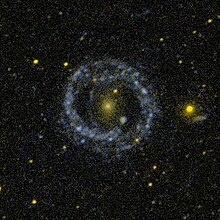| NGC 5701 | |
|---|---|
 NGC 5701 by the Mount Lemmon Observatory | |
| Observation data (J2000 epoch) | |
| Constellation | Virgo |
| Right ascension | 14h 39m 11.0737s [1] |
| Declination | +05° 21′ 48.722″ [1] |
| Redshift | 0.005020 ± 0.000002 [1] |
| Heliocentric radial velocity | 1,505 ± 1 km/s [1] |
| Distance | 50 ± 17 Mly (15.4 ± 5.1 Mpc) [1] |
| Group or cluster | Virgo III Groups |
| Apparent magnitude (V) | 10.9 [2] |
| Characteristics | |
| Type | (R)SB(rs)0/a [1] |
| Size | ~66,000 ly (20.1 kpc) (estimated) [1] |
| Apparent size (V) | 4.3′ × 4.1′ [1] |
| Other designations | |
| UGC 9436, CGCG 047-127, MCG +01-37-042, PGC 52365 [1] | |
NGC 5701 is a barred lenticular galaxy with a ring located in the constellation Virgo. It lies at a distance of about 50 million light years from Earth based on redshift-independent methods, which, given its apparent dimensions, means that NGC 5701 is about 65,000 light years across. [1] Based on redshift the galaxy lies at a distance of 85 million light years. [1] It was discovered by William Herschel on April 29, 1786. [3]
